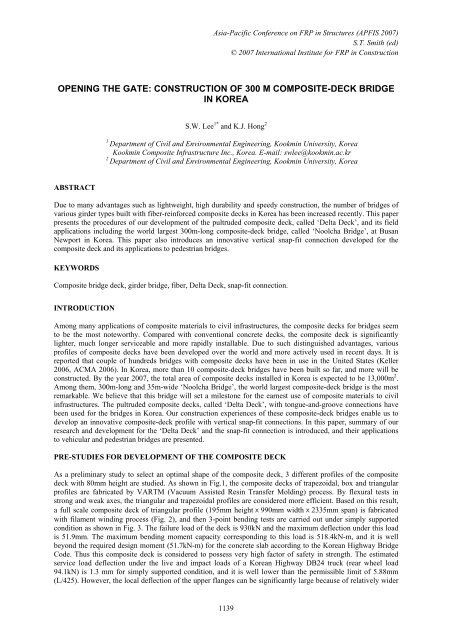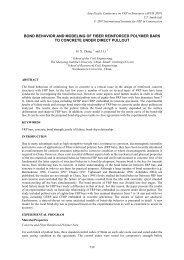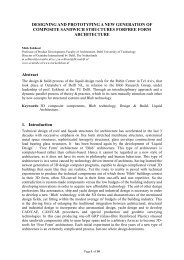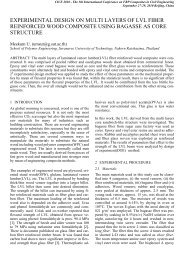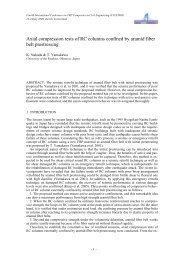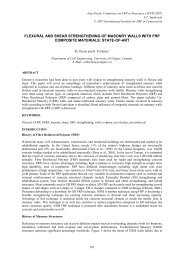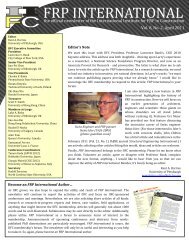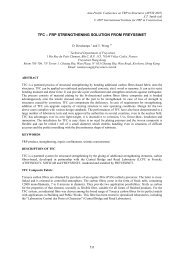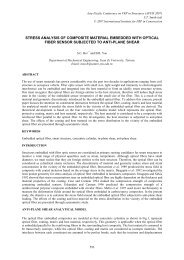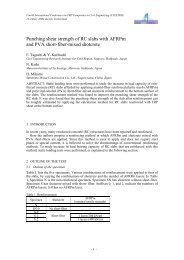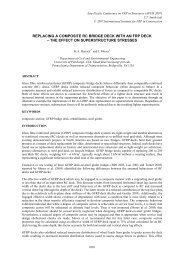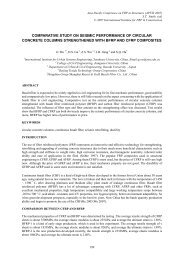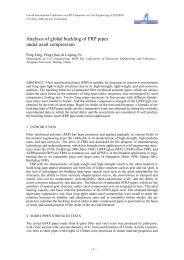construction of 300 m composite-deck bridge in korea
construction of 300 m composite-deck bridge in korea
construction of 300 m composite-deck bridge in korea
You also want an ePaper? Increase the reach of your titles
YUMPU automatically turns print PDFs into web optimized ePapers that Google loves.
Asia-Pacific Conference on FRP <strong>in</strong> Structures (APFIS 2007)<br />
S.T. Smith (ed)<br />
© 2007 International Institute for FRP <strong>in</strong> Construction<br />
OPENING THE GATE: CONSTRUCTION OF <strong>300</strong> M COMPOSITE-DECK BRIDGE<br />
IN KOREA<br />
S.W. Lee 1* and K.J. Hong 2<br />
1<br />
Department <strong>of</strong> Civil and Environmental Eng<strong>in</strong>eer<strong>in</strong>g, Kookm<strong>in</strong> University, Korea<br />
Kookm<strong>in</strong> Composite Infrastructure Inc., Korea. E-mail: swlee@kookm<strong>in</strong>.ac.kr<br />
2<br />
Department <strong>of</strong> Civil and Environmental Eng<strong>in</strong>eer<strong>in</strong>g, Kookm<strong>in</strong> University, Korea<br />
ABSTRACT<br />
Due to many advantages such as lightweight, high durability and speedy <strong>construction</strong>, the number <strong>of</strong> <strong>bridge</strong>s <strong>of</strong><br />
various girder types built with fiber-re<strong>in</strong>forced <strong>composite</strong> <strong>deck</strong>s <strong>in</strong> Korea has been <strong>in</strong>creased recently. This paper<br />
presents the procedures <strong>of</strong> our development <strong>of</strong> the pultruded <strong>composite</strong> <strong>deck</strong>, called ‘Delta Deck’, and its field<br />
applications <strong>in</strong>clud<strong>in</strong>g the world largest <strong>300</strong>m-long <strong>composite</strong>-<strong>deck</strong> <strong>bridge</strong>, called ‘Noolcha Bridge’, at Busan<br />
Newport <strong>in</strong> Korea. This paper also <strong>in</strong>troduces an <strong>in</strong>novative vertical snap-fit connection developed for the<br />
<strong>composite</strong> <strong>deck</strong> and its applications to pedestrian <strong>bridge</strong>s.<br />
KEYWORDS<br />
Composite <strong>bridge</strong> <strong>deck</strong>, girder <strong>bridge</strong>, fiber, Delta Deck, snap-fit connection.<br />
INTRODUCTION<br />
Among many applications <strong>of</strong> <strong>composite</strong> materials to civil <strong>in</strong>frastructures, the <strong>composite</strong> <strong>deck</strong>s for <strong>bridge</strong>s seem<br />
to be the most noteworthy. Compared with conventional concrete <strong>deck</strong>s, the <strong>composite</strong> <strong>deck</strong> is significantly<br />
lighter, much longer serviceable and more rapidly <strong>in</strong>stallable. Due to such dist<strong>in</strong>guished advantages, various<br />
pr<strong>of</strong>iles <strong>of</strong> <strong>composite</strong> <strong>deck</strong>s have been developed over the world and more actively used <strong>in</strong> recent days. It is<br />
reported that couple <strong>of</strong> hundreds <strong>bridge</strong>s with <strong>composite</strong> <strong>deck</strong>s have been <strong>in</strong> use <strong>in</strong> the United States (Keller<br />
2006, ACMA 2006). In Korea, more than 10 <strong>composite</strong>-<strong>deck</strong> <strong>bridge</strong>s have been built so far, and more will be<br />
constructed. By the year 2007, the total area <strong>of</strong> <strong>composite</strong> <strong>deck</strong>s <strong>in</strong>stalled <strong>in</strong> Korea is expected to be 13,000m 2 .<br />
Among them, <strong>300</strong>m-long and 35m-wide ‘Noolcha Bridge’, the world largest <strong>composite</strong>-<strong>deck</strong> <strong>bridge</strong> is the most<br />
remarkable. We believe that this <strong>bridge</strong> will set a milestone for the earnest use <strong>of</strong> <strong>composite</strong> materials to civil<br />
<strong>in</strong>frastructures. The pultruded <strong>composite</strong> <strong>deck</strong>s, called ‘Delta Deck’, with tongue-and-groove connections have<br />
been used for the <strong>bridge</strong>s <strong>in</strong> Korea. Our <strong>construction</strong> experiences <strong>of</strong> these <strong>composite</strong>-<strong>deck</strong> <strong>bridge</strong>s enable us to<br />
develop an <strong>in</strong>novative <strong>composite</strong>-<strong>deck</strong> pr<strong>of</strong>ile with vertical snap-fit connections. In this paper, summary <strong>of</strong> our<br />
research and development for the ‘Delta Deck’ and the snap-fit connection is <strong>in</strong>troduced, and their applications<br />
to vehicular and pedestrian <strong>bridge</strong>s are presented.<br />
PRE-STUDIES FOR DEVELOPMENT OF THE COMPOSITE DECK<br />
As a prelim<strong>in</strong>ary study to select an optimal shape <strong>of</strong> the <strong>composite</strong> <strong>deck</strong>, 3 different pr<strong>of</strong>iles <strong>of</strong> the <strong>composite</strong><br />
<strong>deck</strong> with 80mm height are studied. As shown <strong>in</strong> Fig.1, the <strong>composite</strong> <strong>deck</strong>s <strong>of</strong> trapezoidal, box and triangular<br />
pr<strong>of</strong>iles are fabricated by VARTM (Vacuum Assisted Res<strong>in</strong> Transfer Mold<strong>in</strong>g) process. By flexural tests <strong>in</strong><br />
strong and weak axes, the triangular and trapezoidal pr<strong>of</strong>iles are considered more efficient. Based on this result,<br />
a full scale <strong>composite</strong> <strong>deck</strong> <strong>of</strong> triangular pr<strong>of</strong>ile (195mm heightⅹ990mm widthⅹ2335mm span) is fabricated<br />
with filament w<strong>in</strong>d<strong>in</strong>g process (Fig. 2), and then 3-po<strong>in</strong>t bend<strong>in</strong>g tests are carried out under simply supported<br />
condition as shown <strong>in</strong> Fig. 3. The failure load <strong>of</strong> the <strong>deck</strong> is 930kN and the maximum deflection under this load<br />
is 51.9mm. The maximum bend<strong>in</strong>g moment capacity correspond<strong>in</strong>g to this load is 518.4kN-m, and it is well<br />
beyond the required design moment (51.7kN-m) for the concrete slab accord<strong>in</strong>g to the Korean Highway Bridge<br />
Code. Thus this <strong>composite</strong> <strong>deck</strong> is considered to possess very high factor <strong>of</strong> safety <strong>in</strong> strength. The estimated<br />
service load deflection under the live and impact loads <strong>of</strong> a Korean Highway DB24 truck (rear wheel load<br />
94.1kN) is 1.3 mm for simply supported condition, and it is well lower than the permissible limit <strong>of</strong> 5.88mm<br />
(L/425). However, the local deflection <strong>of</strong> the upper flanges can be significantly large because <strong>of</strong> relatively wider<br />
1139
distance between webs. In order to reduce the local deflection, the <strong>composite</strong> <strong>deck</strong> <strong>of</strong> quasi-triangular pr<strong>of</strong>ile is<br />
selected and fabricated by pultrusion as shown <strong>in</strong> Fig. 4. The pultrusion process is much more efficient than the<br />
filament w<strong>in</strong>d<strong>in</strong>g process especially <strong>in</strong> manufactur<strong>in</strong>g massive products. Extensive analyses and structural tests<br />
on the pultruded <strong>deck</strong>s are carried out. It is found that this pultruded <strong>deck</strong> needs further improvement to meet the<br />
criteria <strong>of</strong> local deflection and fatigue. Based on these pre-studies, the next <strong>deck</strong> pr<strong>of</strong>ile is developed and<br />
summary <strong>of</strong> the development is described <strong>in</strong> the follow<strong>in</strong>g section.<br />
a) Trapezoidal shape b) Box shape c) Triangular shape<br />
Figure 1. Fabrication <strong>of</strong> model <strong>deck</strong>s with VARTM process<br />
Fig. 2 Filament w<strong>in</strong>d<strong>in</strong>g <strong>deck</strong> Fig. 3 Test <strong>of</strong> FW <strong>deck</strong> panel Fig 4. Pultruded <strong>deck</strong><br />
COMPOSITE BRIDGE DECK OF TONGUE-AND-GROOVE CONNECTION – ‘DELTA DECK’<br />
Overview <strong>of</strong> Tongue-and-Groove Pr<strong>of</strong>ile<br />
Through the extensive studies described above, a <strong>composite</strong> <strong>deck</strong> pr<strong>of</strong>ile with tongue-and-groove connections<br />
called ‘Delta Deck’ is developed (Lee 2004). As shown <strong>in</strong> Fig. 5, it has 3 trapezoidal cells with 200mm height.<br />
The <strong>deck</strong> is designed for the Korean Highway DB24 truck load with typical girder spac<strong>in</strong>g <strong>of</strong> 2.5~3.0m. As<br />
shown <strong>in</strong> Fig. 6, the pultruded <strong>deck</strong> tubes are assembled together by bond<strong>in</strong>g each other to make a complete <strong>deck</strong><br />
panel. In each lam<strong>in</strong>ate <strong>of</strong> the <strong>deck</strong>, 8800 Tex E-glass rov<strong>in</strong>g <strong>in</strong> the longitud<strong>in</strong>al direction and multi-axial<br />
stitched fabrics (90°/±45°) <strong>in</strong> the transverse direction are used. Unsaturated polyester is employed as res<strong>in</strong> base.<br />
Fig.5 Pr<strong>of</strong>ile <strong>of</strong> ‘Delta Deck’ Fig. 6 Assembly by tongue-and-groove Fig. 7 Pultrusion <strong>of</strong> <strong>deck</strong> tube<br />
Research Summary for Tongue-and-Groove Composite Deck<br />
F<strong>in</strong>ite element analysis is carried out to verify strength and serviceability <strong>of</strong> the designed <strong>composite</strong> <strong>deck</strong>. A<br />
plate girder <strong>bridge</strong> simply supported with 30m span hav<strong>in</strong>g 5 girders with 2.5m spac<strong>in</strong>g is considered. Analysis<br />
is performed for the DB24 truck load (Fig. 8). As analysis results, the designed <strong>deck</strong> is considered to possess<br />
2.53 factor <strong>of</strong> safety for deflection (L/425 criteria), 10.4 for Tsai-Wu failure criteria and 10.7 for web buckl<strong>in</strong>g<br />
(Hyer 1988). The <strong>composite</strong> <strong>deck</strong> tube <strong>of</strong> 3-cell trapezoidal section with 200mm height, called ‘Delta-<strong>deck</strong>’ are<br />
fabricated by pultrusion process (Fig. 7). Coupon tests, flexural tests (Fig. 9), shear tests (Fig. 10), compression<br />
fatigue tests (Fig. 11), flexural fatigue tests, barrier wall tests, pavement shear tests and various chemical tests<br />
are carried out for this <strong>deck</strong>. Fig. 12 shows results <strong>of</strong> compression fatigue test under 2-million cycles <strong>of</strong> wheel<br />
APFIS 2007 1140
load <strong>of</strong> DB 24 truck. As shown <strong>in</strong> Fig. 12, stra<strong>in</strong>s after 2-million cycles do not have significant change, thus it<br />
verifies good fatigue resistance <strong>of</strong> the <strong>deck</strong>. S<strong>in</strong>ce the <strong>composite</strong> <strong>deck</strong> has high durability and good fatigue<br />
resistance, its service life is expected to be longer than typical concrete <strong>deck</strong>s that have relatively low durability<br />
and low fatigue resistance due to cracks. After extensive structural performance tests <strong>in</strong> the laboratory as<br />
described above, the developed pultruded <strong>deck</strong> is <strong>in</strong>stalled on a demonstration <strong>bridge</strong> <strong>of</strong> plate girder type <strong>in</strong> the<br />
lane enlargement project <strong>of</strong> Gyungbu Highway. Field load tests are carried out on this demonstration <strong>bridge</strong> as<br />
shown <strong>in</strong> Fig. 13. The maximum deflection <strong>of</strong> the <strong>deck</strong> is measured 1.92mm under a test truck load. Permissible<br />
deflection for the 2.0m girder spac<strong>in</strong>g is estimated as 4.7mm when deflection serviceability criterion <strong>of</strong><br />
L/425(2m/425) is applied. Thus the factor <strong>of</strong> safety 2.4 <strong>in</strong> deflection is obta<strong>in</strong>ed under the test truck load. When<br />
the test truck load is converted to a DB24 truck load, factor <strong>of</strong> safety is estimated to 2.9 <strong>in</strong> serviceability and 39<br />
<strong>in</strong> strength. From the field load tests, it is demonstrated that developed pultruded <strong>deck</strong> possesses sufficient<br />
serviceability and strength. Results <strong>of</strong> dynamic field load tests on another <strong>bridge</strong> (Gwangyang Bridge <strong>in</strong> Fig. 21),<br />
not shown <strong>in</strong> this paper, verify that the developed <strong>deck</strong> pr<strong>of</strong>ile well satisfies the strength and serviceability<br />
criteria under the Korean Highway truck load. Several field applications <strong>of</strong> the developed <strong>deck</strong> are described<br />
below.<br />
Fig. 8 FE analysis <strong>of</strong> <strong>deck</strong> Fig. 9 Flexural test <strong>of</strong> <strong>deck</strong> panel Fig. 10 Connection shear test<br />
Fig. 11 Compression fatigue test Fig. 12 Results <strong>of</strong> fatigue test Fig. 13 Field load test <strong>of</strong> <strong>deck</strong><br />
COMPOSITE DECK OF VERTICAL SNAP-FIT CONNECTION<br />
Overview <strong>of</strong> Snap-Fit Pr<strong>of</strong>ile<br />
Until today tongue-and-groove connections, shown above, is prevail<strong>in</strong>g practice <strong>in</strong> assembl<strong>in</strong>g <strong>composite</strong> <strong>deck</strong>s.<br />
In conventional <strong>bridge</strong> <strong>construction</strong>, shear connectors are provided at plant on top <strong>of</strong> girders prior to plac<strong>in</strong>g<br />
<strong>deck</strong>s. However, <strong>in</strong> <strong>in</strong>stall<strong>in</strong>g <strong>composite</strong> <strong>deck</strong>s with tongue-and-groove connection, shear connectors can not be<br />
provided until the <strong>composite</strong> <strong>deck</strong>s are completely assembled. The <strong>deck</strong> should be assembled side by side<br />
horizontally on top <strong>of</strong> girders without hav<strong>in</strong>g disturbance <strong>of</strong> vertical shear studs. Installation <strong>of</strong> shear connectors<br />
through pre-drilled small conf<strong>in</strong>ed holes <strong>in</strong> the <strong>composite</strong> <strong>deck</strong> causes poor workability and weld<strong>in</strong>g quality so<br />
that it requires more costs and time. If the girders are made <strong>of</strong> concrete, <strong>in</strong>stallation process <strong>of</strong> shear connector is<br />
far more difficult. In addition, accumulated horizontal gap between bonded tubes becomes larger for the longer<br />
<strong>bridge</strong> so that it creates significant differences <strong>in</strong> length <strong>of</strong> the <strong>deck</strong> panel dur<strong>in</strong>g <strong>construction</strong>. To resolve these<br />
problems, an <strong>in</strong>novative <strong>composite</strong> <strong>deck</strong> pr<strong>of</strong>ile with vertical snap-fit connection is newly developed (Lee 2006).<br />
Fig. 14 shows the developed pr<strong>of</strong>ile <strong>of</strong> snap-fit <strong>deck</strong> for vehicular <strong>bridge</strong> and Fig. 15 shows illustration <strong>of</strong> <strong>deck</strong><br />
assembly by snap-fitt<strong>in</strong>g. The developed snap-fit <strong>deck</strong>, assembled each other <strong>in</strong> a vertical direction by snap-fit<br />
connection, significantly improves <strong>construction</strong> workability and quality, provides snap-fit mechanical connection<br />
with or without adhesive bond<strong>in</strong>g, and saves <strong>in</strong>stallation time and costs. Another notable improvement <strong>of</strong> the<br />
snap-fit <strong>deck</strong> is easy applicability to curved <strong>bridge</strong>s, while the <strong>deck</strong> <strong>of</strong> tongue-and-groove type practically cannot<br />
be implemented to. The vertical snap-fit connection provides easy assembly and disassembly by mechanical<br />
snap-fitt<strong>in</strong>g. Thus, applications <strong>of</strong> the snap-fit <strong>deck</strong> can further be extended not only to temporary <strong>bridge</strong>s, but<br />
also to road-mats for oil and gas development, disaster relief, military operation, m<strong>in</strong><strong>in</strong>g, logg<strong>in</strong>g and<br />
<strong>construction</strong>. It is hoped that the development <strong>of</strong> this vertical snap-fit connection will lead far wider applications<br />
<strong>of</strong> the <strong>composite</strong> <strong>deck</strong>s.<br />
APFIS 2007 1141
Fig. 14 Pr<strong>of</strong>ile <strong>of</strong> snap-fit <strong>deck</strong> Fig. 15 Deck assembly by snap-fit Fig. 16 Test for snap-fit assembly<br />
Research Summary for Snap-Fit Composite Deck<br />
For the vehicular <strong>deck</strong> with snap-fit connection shown <strong>in</strong> Fig. 14, f<strong>in</strong>ite element analysis is performed. It is found<br />
that firm connection is guaranteed and sufficient safety <strong>in</strong> strength is preserved at the connection when snap-fit is<br />
properly designed. To understand structural behavior dur<strong>in</strong>g the snap-fit action, geometric nonl<strong>in</strong>ear analyses are<br />
also performed. The results <strong>of</strong> analyses show that designed snap-fit <strong>deck</strong> well satisfies the Tsai-Wu failure<br />
criteria dur<strong>in</strong>g snap-<strong>in</strong> assembly and snap-out disassembly, and the safety factor is greater than 2.8. The <strong>deck</strong><br />
pr<strong>of</strong>ile <strong>of</strong> 75mm height with snap-fit connection is fabricated by pultrusion. For this pultruded <strong>deck</strong>, tests on<br />
snap-fit action are conducted as shown <strong>in</strong> Fig. 16. Due to limited space <strong>of</strong> this paper, the results <strong>of</strong> the tests are<br />
not shown, but the stresses and deflections under tests are similar to those from the analyses.<br />
APPLICATIONS OF COMPOSITE BRIDGE DECK TO VEHICULAR BRIDGES<br />
Background<br />
For the developed <strong>composite</strong> <strong>deck</strong> ‘Delta Deck’, extensive verifications at laboratory and field are carried out<br />
before its actual use. Based on the excellent field performance for the demonstration <strong>bridge</strong>s at <strong>construction</strong> site<br />
<strong>in</strong> 2002 and at detour <strong>bridge</strong> <strong>of</strong> Kyungbu Highway <strong>in</strong> 2004, more <strong>composite</strong>-<strong>deck</strong> <strong>bridge</strong>s <strong>of</strong> various girder types<br />
are be<strong>in</strong>g built and the number <strong>of</strong> the <strong>composite</strong>-<strong>deck</strong> <strong>bridge</strong>s is cont<strong>in</strong>uously <strong>in</strong>creas<strong>in</strong>g <strong>in</strong> Korea.<br />
The World Largest Composite-Deck Bridge <strong>of</strong> Re<strong>in</strong>forced Concrete (RC) Girder<br />
The world largest <strong>composite</strong>-<strong>deck</strong> <strong>bridge</strong>, called ‘Noolcha Bridge’, is currently under <strong>construction</strong> <strong>in</strong> Busan new<br />
port, located <strong>in</strong> the southeastern coast <strong>of</strong> the Korean pen<strong>in</strong>sula. This <strong>bridge</strong> is pier-type, <strong>300</strong>m long and 35m<br />
wide, and will be completed by October 2007. The <strong>composite</strong> <strong>deck</strong>, ‘Delta Deck’, is <strong>in</strong>stalled on grids <strong>of</strong><br />
re<strong>in</strong>forced concrete girder (Fig. 17), which is constructed above the steel mar<strong>in</strong>e pile foundation (Fig. 18). The<br />
<strong>composite</strong> <strong>deck</strong> is selected for this <strong>bridge</strong> to take benefits <strong>of</strong> cost sav<strong>in</strong>gs <strong>in</strong> <strong>construction</strong> and ma<strong>in</strong>tenance. Due<br />
to the light weight property <strong>of</strong> the <strong>composite</strong> <strong>deck</strong>, it significantly reduces number <strong>of</strong> foundation mar<strong>in</strong>e piles so<br />
that the <strong>in</strong>itial <strong>construction</strong> cost is reduced considerably. In addition, due to high durability <strong>of</strong> the <strong>composite</strong> <strong>deck</strong><br />
aga<strong>in</strong>st mar<strong>in</strong>e environment, the life-cycle cost is also reduced remarkably. Fast erection also gives sav<strong>in</strong>gs <strong>in</strong><br />
<strong>construction</strong> time and costs. Upon completion <strong>of</strong> the <strong>deck</strong> panel on the southbound (<strong>deck</strong> <strong>in</strong> left-hand side <strong>in</strong> Fig.<br />
19), this portion is utilized as a work site for <strong>construction</strong> equipments such as pump-cars and remicon trucks to<br />
place concrete to build girders on the northbound (right-hand side <strong>in</strong> Fig. 17 and 19). By this way, it can speed<br />
up the <strong>construction</strong> dramatically. Fig. 17 shows lift<strong>in</strong>g and erection <strong>of</strong> <strong>deck</strong> panel from storage yard onto the<br />
<strong>bridge</strong> girder on the northbound. The placed <strong>deck</strong>s above the girders are assembled side by side with adhesive<br />
Fig. 17 Installation at Noolcha Br. Fig. 18 Side view <strong>of</strong> <strong>in</strong>stalled <strong>deck</strong> Fig. 19 View after <strong>in</strong>stallation<br />
APFIS 2007 1142
ond<strong>in</strong>g. After completion <strong>of</strong> <strong>deck</strong> placement, shear connectors are <strong>in</strong>stalled on the girder. Then, non-shr<strong>in</strong>kage<br />
concrete is placed around shear connectors to have <strong>composite</strong> action between the girders and the <strong>composite</strong><br />
<strong>deck</strong>s. Installation <strong>of</strong> the <strong>composite</strong> <strong>deck</strong> has been completed so far as shown <strong>in</strong> Fig. 19. Asphalt concrete<br />
pavement will be glued to the <strong>composite</strong> <strong>deck</strong> by us<strong>in</strong>g epoxy and quartz sands (Lee 2004).<br />
Composite-Deck Bridge <strong>of</strong> Steel Plate Girder – Non-Composite Action between Deck and Girder<br />
After 2 demonstration works <strong>in</strong>clud<strong>in</strong>g Kyungbu Highway detour described above, another large temporary<br />
<strong>bridge</strong> <strong>of</strong> plate girder, ‘Gwangyang Bridge’, located <strong>in</strong> the southwestern coast <strong>of</strong> the Korean pen<strong>in</strong>sula have been<br />
constructed with Delta Decks <strong>in</strong> 2004 (Fig. 20, 21). It is 150m long and 10.4m wide. Though this <strong>bridge</strong> is<br />
temporary, it will be used more than 10 years dur<strong>in</strong>g the long <strong>construction</strong> period <strong>of</strong> reclamation.<br />
Composite-Deck Bridge <strong>of</strong> Steel Plate Girder – Composite Action between Deck and Girder<br />
After successful implementation to the temporary <strong>bridge</strong>s, Delta Decks have been <strong>in</strong>stalled on the permanent<br />
plate girder <strong>bridge</strong>, ‘Gaejung Bridge’, located at the southern <strong>in</strong>land <strong>of</strong> the Korean pen<strong>in</strong>sula <strong>in</strong> 2004 (Fig. 22,<br />
23). It is 25m long and 11m wide. No <strong>in</strong>dication <strong>of</strong> defects is found s<strong>in</strong>ce the <strong>bridge</strong> is opened to the traffic.<br />
Composite-Deck Bridge <strong>of</strong> Prestressed Concrete (PC) Girder<br />
With several <strong>construction</strong> experiences for the steel girder <strong>bridge</strong>s, Delta Decks have been successfully <strong>in</strong>stalled<br />
for a <strong>bridge</strong> with prestressed concrete girders <strong>in</strong> 2005 (Fig. 24, 25). This <strong>bridge</strong> is called ‘Pyungtaek Bridge’ and<br />
located at the western coast <strong>of</strong> the Korean pen<strong>in</strong>sula. It is 70m long and 11.9m wide and consists <strong>of</strong> 2 simply<br />
supported spans.<br />
Fig. 20 Installation at Gwangyang Br. Fig. 21 Gwangyang Br. at service Fig. 22 Installation at Gaejung Br.<br />
Fig. 23 Gaejung Br. at service Fig. 24 Installation at Pyungtaek Br. Fig. 25 Pyungtaek Br. at service<br />
APPLICATIONS OF COMPOSITE BRIDGE DECK TO PEDESTRIAN BRIDGES<br />
‘Delta Deck’ Applied to Pedestrian Part <strong>of</strong> Arch Bridge<br />
To cope with requirement <strong>of</strong> m<strong>in</strong>imal traffic block<strong>in</strong>g dur<strong>in</strong>g the environmental recovery project <strong>of</strong> Seoul<br />
Metropolitan city <strong>in</strong> 2005, Delta Deck is applied to build pedestrian side ways for an arch <strong>bridge</strong>, shown <strong>in</strong> Fig.<br />
26. The <strong>bridge</strong> is 44.5m long and 9m wide, and has pedestrian way on both sides. Delta Decks are boltconnected<br />
to the cross beam with shear stud. Fig. 27 shows the completed <strong>bridge</strong> <strong>in</strong> use over the reopened<br />
environment-friendly ‘Cheongae River’.<br />
Composite Snap-Fit Deck on Suspension Pedestrian Bridge<br />
The <strong>deck</strong> pr<strong>of</strong>ile with the vertical snap-fit connection described above is considered very effective <strong>in</strong><br />
construct<strong>in</strong>g pedestrian <strong>bridge</strong>s. In addition to light weight and high durability, it provides an extra benefit <strong>of</strong><br />
APFIS 2007 1143
easy assembly and disassembly by mechanical snap-fit. As shown <strong>in</strong> Figs. 28 and 29, the developed snap-fit<br />
<strong>deck</strong> is successfully implemented to the suspension pedestrian <strong>bridge</strong>, ‘Wolchul-Mounta<strong>in</strong> Bridge’, which is<br />
53m long and 1m wide completed <strong>in</strong> 2006.<br />
Composite Snap-Fit Deck on Arch Bridge with Steel Box Girder<br />
The snap-fit <strong>composite</strong> <strong>deck</strong> is simply and elegantly placed above the steel box girder without brackets at both<br />
cantilevered sides <strong>in</strong> ‘Osanchun Bridge’, which is 140m long and 5m wide. Fig. 30 shows <strong>in</strong>stallation work and<br />
Fig. 31 shows the <strong>bridge</strong> <strong>in</strong> use after completion. As shown <strong>in</strong> Fig. 31, the beautiful scenery <strong>of</strong> the <strong>bridge</strong> makes<br />
environmental-friendly atmosphere to neighbor<strong>in</strong>g citizens.<br />
Fig. 26 Installation at Cheongae Br. Fig. 27 Cheongge Br. at service<br />
Fig. 28 Installation at Wolchul Br.<br />
Fig. 29 Wolchul Br. at service Fig. 30 Installation at Osan Br. Fig. 31 Osan Br. at service<br />
CONCLUSION<br />
The pr<strong>of</strong>iles <strong>of</strong> <strong>composite</strong> <strong>deck</strong>, ‘Delta Deck’, with the tongue-and-groove connection and the vertical snap-fit<br />
connection are <strong>in</strong>troduced. The development procedures and several successful field applications <strong>of</strong> ‘Delta Deck’<br />
to vehicular and pedestrian <strong>bridge</strong>s <strong>of</strong> various girder types, <strong>in</strong>clud<strong>in</strong>g the word largest <strong>composite</strong>-<strong>deck</strong> <strong>bridge</strong>,<br />
“Noolcha Bridge’, are also presented. It is believed that ‘Noolcha Bridge’ will set a milestone for the earnest use<br />
<strong>of</strong> <strong>composite</strong> materials to civil <strong>in</strong>frastructures. Due to many advantages <strong>of</strong> the <strong>composite</strong> <strong>deck</strong>, <strong>in</strong>creas<strong>in</strong>g<br />
number <strong>of</strong> applications is anticipated <strong>in</strong> the near future.<br />
ACKNOWLEDGEMENT<br />
The study presented <strong>in</strong> this paper is supported by the Korea Science and Eng<strong>in</strong>eer<strong>in</strong>g Foundation (Grant no:<br />
R01-2004-000-10696-0) and the Korean M<strong>in</strong>istry <strong>of</strong> Construction and Transportation (Construction Core<br />
Technology R&D 06-C04 and 01-Mokjeok A01). The author gratefully acknowledge these supports.<br />
REFERENCES<br />
Keller, T. (2003). Use <strong>of</strong> Fiber Re<strong>in</strong>forced Polymers <strong>in</strong> Bridge Construction, Structural Eng<strong>in</strong>eer<strong>in</strong>g Documents<br />
7, IABSE, Switzerland.<br />
Lee, S.W. (2004). Development <strong>of</strong> High Durable, Light Weight and Fast Installable Composite Deck, MOCT<br />
Report, M<strong>in</strong>istry <strong>of</strong> Construction and Transportation, Korea.<br />
Lee, S.W. (2006). Fiber Re<strong>in</strong>forced Polymer Composite Bridge Deck <strong>of</strong> Tubular Pr<strong>of</strong>ile Hav<strong>in</strong>g Vertical Snap-<br />
Fit Connection, US Patent No. US 7, 131, 161 B2, USA.<br />
www.mda<strong>composite</strong>s.org (2006). ACMA (American Composites Manufacturers Association), New York, USA.<br />
Hyer M.W. (1988). Stress Analysis <strong>of</strong> Fiber-Re<strong>in</strong>forced Composite Materials, Mc Graw Hill<br />
APFIS 2007 1144


